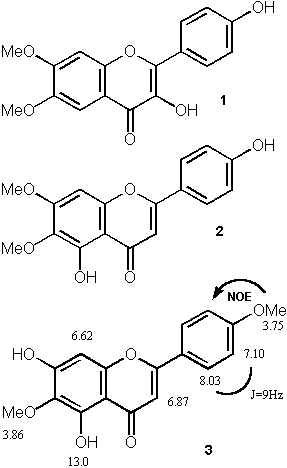What is Hortensin?
Hase, Ohtani, Kasai,
Yamasaki and Chayan, Phytochemistry, 40, 287-289 (1995)
<PDF file>.
 A
flavonoid we isolated from Thai medicinal plant, Millingtonia
hortensis (Bignoniaceae) was identical with hortensin isolated from the same plant, as far as physicochemical
constants are concerned. And the structure proposed for this compound
is 1 (Figure).
A
flavonoid we isolated from Thai medicinal plant, Millingtonia
hortensis (Bignoniaceae) was identical with hortensin isolated from the same plant, as far as physicochemical
constants are concerned. And the structure proposed for this compound
is 1 (Figure).
Bunyapraphatsara et al,
Phytochemistry, 28, 1555 (1989).
The other group isolated the same compound
from the same plant in 1992, and they
synthesized "hortensin" (1) for confirmation. However, the synthesized
compound was not identical with natural one. So, they proposed
the different structure (2) for "hortensin". The compound 2 was a known flavonoid [circimaritin] already
isolated from Flourensia ceruna (Compositae).
Nair et al, Phytochemistry,
31, 671 (1992).
We also isolated "hortensin" from the same plant. The all physico-chemical data
were identical with those of the two previous paper. Hoever, by
reading NMR spectra, especially NOE, the structure
was readily determined as 3.
The Compound 3 is
also known compound [pectolinarigenin*]
previously isolated
from Digitalis schischkinii.Å@So, the name of "Hortensin"
should be withdrawn.
*Imre et al, Phytochemistry,
16, 799 (1977)
Even in these days (1990s) where modern
NMR measurements are available, this sort of mistake may happen
for such a simple structure. Young students should stick to
their work diligently and in detail, then they might make
one paper as we did.
Don't call us
SCAVENGER !!
back to Thai Collaboration
back to Research
 A
flavonoid we isolated from Thai medicinal plant, Millingtonia
hortensis (Bignoniaceae) was identical with hortensin isolated from the same plant, as far as physicochemical
constants are concerned. And the structure proposed for this compound
is 1 (Figure).
A
flavonoid we isolated from Thai medicinal plant, Millingtonia
hortensis (Bignoniaceae) was identical with hortensin isolated from the same plant, as far as physicochemical
constants are concerned. And the structure proposed for this compound
is 1 (Figure).